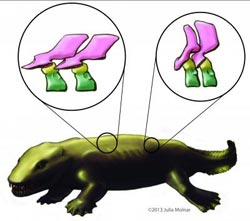Scientists reassemble the backbone of life with a particle acceleratorynchrotron X-rays

This is an artist's impression of an Ichthyostega Tetrapod, with the cut-out showing the 3-D reconstruction of two vetrebrae from the study.<br><br>Credit: Julia Molnar<br>
Jointly issued with STFC and the Royal Veterinary College London.
Scientists have been able to reconstruct, for the first time, the intricate three-dimensional structure of the backbone of early tetrapods, the earliest four-legged animals. High-energy X-rays and a new data extraction protocol allowed the researchers to reconstruct the backbones of the 360 million year old fossils in exceptional detail and shed new light on how the first vertebrates moved from water onto land. The results are published 13 January 2013 in Nature.
The international team of scientists was led by Stephanie E. Pierce from The Royal Veterinary College in London and Jennifer A. Clack from the University of Cambridge. It also comprised scientists from Uppsala University (Sweden) and the European Synchrotron Radiation Facility ESRF in Grenoble (France).
The tetrapods are four-limbed vertebrates, which are today represented by amphibians, reptiles, birds and mammals. Around 400 million years ago, early tetrapods were the first vertebrates to make short excursions into shallower waters where they used their four limbs for moving around. How this happened and how they then transferred to land is a subject of intense debate among palaeontologists and evolution biologists.
All tetrapods have a backbone, or vertebral column, which is a bony structure common to all other vertebrates including fish, from which tetrapods evolved. A backbone is formed from vertebrae connected in a row – from head to tail. Unlike the backbone of living tetrapods (e.g. humans), in which each vertebra is composed of only one bone, early tetrapods had vertebrae made up of multiple parts.
“For more than 100 years, early tetrapods were thought to have vertebrae composed of three sets of bones – one bone in front, one on top, and a pair behind. But, by peering inside the fossils using synchrotron X-rays we have discovered that this traditional view literally got it back-to-front,” says Stephanie Pierce who is the lead author of the publication.
For the analysis, the European Synchrotron Radiation Facility (ESRF) in France, where the three fossil fragments were scanned with X-rays, applied a data extraction method to reveal tiny details of fossil bones buried deep inside the rock matrix. The fossilised bones are embedded in rock so dense it absorbs most of the X-rays. “Without the new method, it would not have been possible to reveal the elements of the spine in three dimensions with a resolution of 30 micrometres” says Sophie Sanchez from University of Uppsala and ESRF who is a co-author of the publication.
In these high-resolution X-ray images, the scientists discovered that what was thought to be the first bone – known as the intercentrum – is actually the last in the series. And, although this might seem like a trivial oversight, this re-arrangement in vertebral structure has over-arching ramifications for the functional evolution of the tetrapod backbone.
Stephanie Pierce explains: “By understanding how each of the bones fit together we can begin to explore the mobility of the spine and test how it may have transferred forces between the limbs during the early stages of land movement”.
But, the findings didn't end there. One of the animals – known as Ichthyostega – was also found to have an assortment of hitherto unknown skeletal features including a string of bones extending down the middle of its chest.
Jennifer Clack says: “These chest bones turned out to be the earliest evolutionary attempt to produce a bony sternum. Such a structure would have strengthened the ribcage of Ichthyostega, permitting it to support its body weight on its chest while moving about on land.”
This unexpected discovery supports recent work by Pierce and Clack that showed Ichthyostega probably moved by dragging itself across flat ground using synchronous 'crutching' motions of its front legs – much like that of a mudskipper or seal. Dr Pierce adds: “The results of this study force us to re-write the textbook on backbone evolution in the earliest limbed animals.”
“At the ESRF, the new data extraction protocol makes it possible to study fossils in dense and heavy rock in unprecedented detail. What we have seen today is only the beginning of more surprises to come,” concludes Sophie Sanchez.
Reference:
Stephanie E Pierce, Per E Ahlberg, John R Hutchinson, Julia L Molna, Sophie Sanchez, Paul Tafforeau, and Jennifer A Clack: Vertebral architecture in the earliest stem tetrapods, Nature advanced online publication 13 January 2013, DOI: 10.1038/nature11825.
Media Contact
More Information:
http://www.esrf.frAll latest news from the category: Earth Sciences
Earth Sciences (also referred to as Geosciences), which deals with basic issues surrounding our planet, plays a vital role in the area of energy and raw materials supply.
Earth Sciences comprises subjects such as geology, geography, geological informatics, paleontology, mineralogy, petrography, crystallography, geophysics, geodesy, glaciology, cartography, photogrammetry, meteorology and seismology, early-warning systems, earthquake research and polar research.
Newest articles

Bringing bio-inspired robots to life
Nebraska researcher Eric Markvicka gets NSF CAREER Award to pursue manufacture of novel materials for soft robotics and stretchable electronics. Engineers are increasingly eager to develop robots that mimic the…

Bella moths use poison to attract mates
Scientists are closer to finding out how. Pyrrolizidine alkaloids are as bitter and toxic as they are hard to pronounce. They’re produced by several different types of plants and are…

AI tool creates ‘synthetic’ images of cells
…for enhanced microscopy analysis. Observing individual cells through microscopes can reveal a range of important cell biological phenomena that frequently play a role in human diseases, but the process of…





















